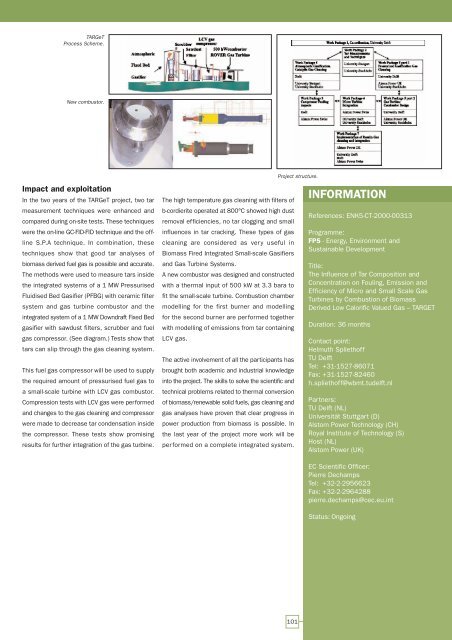European Bio-Energy Projects
European Bio-Energy Projects
European Bio-Energy Projects
You also want an ePaper? Increase the reach of your titles
YUMPU automatically turns print PDFs into web optimized ePapers that Google loves.
TARGeT<br />
Process Scheme.<br />
New combustor.<br />
Impact and exploitation<br />
In the two years of the TARGeT project, two tar<br />
measurement techniques were enhanced and<br />
compared during on-site tests. These techniques<br />
were the on-line GC-FID-FID technique and the offline<br />
S.P.A technique. In combination, these<br />
techniques show that good tar analyses of<br />
biomass derived fuel gas is possible and accurate.<br />
The methods were used to measure tars inside<br />
the integrated systems of a 1 MW Pressurised<br />
Fluidised Bed Gasifier (PFBG) with ceramic filter<br />
system and gas turbine combustor and the<br />
integrated system of a 1 MW Downdraft Fixed Bed<br />
gasifier with sawdust filters, scrubber and fuel<br />
gas compressor. (See diagram.) Tests show that<br />
tars can slip through the gas cleaning system.<br />
This fuel gas compressor will be used to supply<br />
the required amount of pressurised fuel gas to<br />
a small-scale turbine with LCV gas combustor.<br />
Compression tests with LCV gas were performed<br />
and changes to the gas cleaning and compressor<br />
were made to decrease tar condensation inside<br />
the compressor. These tests show promising<br />
results for further integration of the gas turbine.<br />
The high temperature gas cleaning with filters of<br />
b-cordierite operated at 800°C showed high dust<br />
removal efficiencies, no tar clogging and small<br />
influences in tar cracking. These types of gas<br />
cleaning are considered as very useful in<br />
<strong>Bio</strong>mass Fired Integrated Small-scale Gasifiers<br />
and Gas Turbine Systems.<br />
A new combustor was designed and constructed<br />
with a thermal input of 500 kW at 3.3 bara to<br />
fit the small-scale turbine. Combustion chamber<br />
modelling for the first burner and modelling<br />
for the second burner are performed together<br />
with modelling of emissions from tar containing<br />
LCV gas.<br />
The active involvement of all the participants has<br />
brought both academic and industrial knowledge<br />
into the project. The skills to solve the scientific and<br />
technical problems related to thermal conversion<br />
of biomass/renewable solid fuels, gas cleaning and<br />
gas analyses have proven that clear progress in<br />
power production from biomass is possible. In<br />
the last year of the project more work will be<br />
performed on a complete integrated system.<br />
Project structure.<br />
101<br />
INFORMATION<br />
References: ENK5-CT-2000-00313<br />
Programme:<br />
FP5 - <strong>Energy</strong>, Environment and<br />
Sustainable Development<br />
Title:<br />
The Influence of Tar Composition and<br />
Concentration on Fouling, Emission and<br />
Efficiency of Micro and Small Scale Gas<br />
Turbines by Combustion of <strong>Bio</strong>mass<br />
Derived Low Calorific Valued Gas – TARGET<br />
Duration: 36 months<br />
Contact point:<br />
Helmuth Spliethoff<br />
TU Delft<br />
Tel: +31-1527-86071<br />
Fax: +31-1527-82460<br />
h.spliethoff@wbmt.tudelft.nl<br />
Partners:<br />
TU Delft (NL)<br />
Universität Stuttgart (D)<br />
Alstom Power Technology (CH)<br />
Royal Institute of Technology (S)<br />
Host (NL)<br />
Alstom Power (UK)<br />
EC Scientific Officer:<br />
Pierre Dechamps<br />
Tel: +32-2-2956623<br />
Fax: +32-2-2964288<br />
pierre.dechamps@cec.eu.int<br />
Status: Ongoing

















